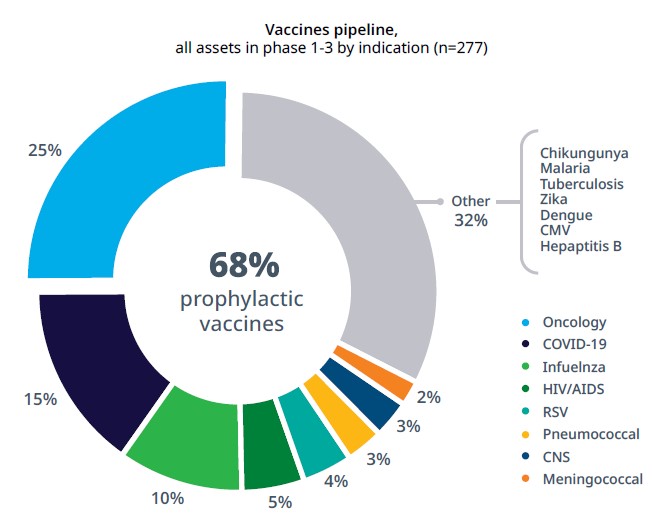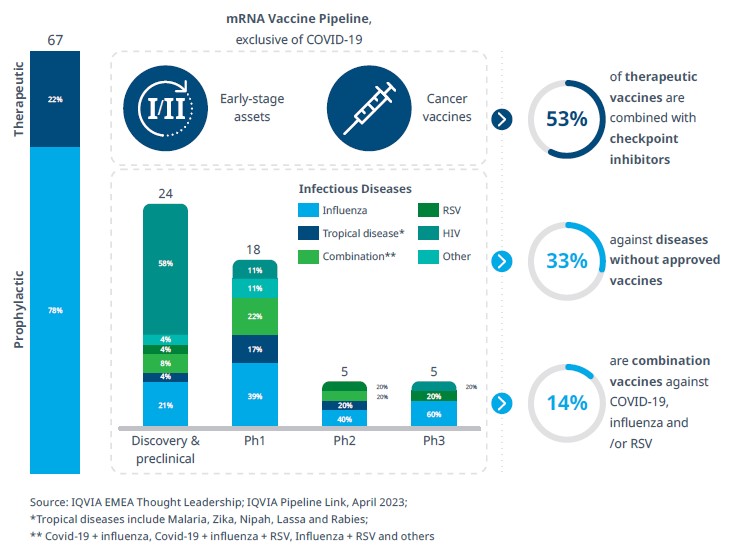





















- Blogs
- Advances in Vaccine Technology
Vaccination remains a highly effective public health intervention, saving an estimated 4-5 million lives per year, and is also highly cost-effective, reducing future health-related costs by $4 for every $1 spent on adult immunization.1
While recent vaccine approvals have focused on COVID-1, there has also been innovation in other disease areas, including respiratory syncytial virus (RSV) vaccines, with the first such vaccine approved in 2023.2 The pandemic and the race to develop an effective vaccine led to more vaccine clinical trials, which expanded by 14% between 2017 and 2022, accounting for 7% of the overall industry pipeline in 2022.1 COVID-19 vaccines represented 15% of the pipeline (Figure 1).
Figure 1: COVID-19 vaccines account for 15% of the vaccines pipeline1

The widespread use of mRNA-based COVID-19 vaccines validated the real-world safety, efficacy and scalability of this technology, which was given emergency use authorization some 7 months after initial clinical trial dosing, yet was based on more than 50 years of research. As of May 11, 2023, 677 million doses of COVID-19 vaccines had been administered in the US.3 Based on this large-scale vaccine use and needs for the future, there were five key learnings:
- COVID-19 vaccine durability is not as long as originally hoped, with a need for multiple, frequent boosters to achieve high efficacy. This imposes a cost burden, especially for high-risk patients who may require the most boosters. This need for frequent boosters is unusual among vaccines, with some, such as the one for measles, able to provide lifelong protection and others, such as the tetanus vaccine, requiring boosters only every 10 years.
- There is potential for vaccines focused on T-cell immunity: COVID vaccines to date have primarily focused on the development of antibodies. Innovative, newer vaccines are focusing on inducing T-cell immunity, which is longer lasting. The Biomedical Advanced Research and Development Authority (BARDA) is funding research in this area, recently awarding $1.4 billion to develop a new generation of tools and technologies to protect against COVID-19.4 Innovations include temperature-stable vaccines, and formulations suitable for nasal administration, which would be particularly useful in low- and middle-income countries.
- High risk populations should be part of the vaccine trials: Many of the early COVID vaccine trials used only healthy volunteers. However, it is important to pay attention to high-risk population subsets including those aged 65 and over, and those with obesity, diabetes, hypertension, and cardiovascular disease. These must now account for a mandated proportion of vaccine study populations, which should inform future administration strategies.
- Combination vaccines are needed, including ones for both COVID, influenza and respiratory syncytial virus (RSV), which will require ongoing tracking of strains around the world. Currently, some 14% of the mRNA vaccines pipeline are accounted for by combination vaccines for COVID-19, influenza and RSV (Figure 2).
Figure 2: The R&D pipeline for mRNA vaccines1

Looking ahead, COVID-19 vaccine development efforts are moving towards a goal of longer-lasting vaccines that require fewer doses, and combination vaccines that provide protection against multiple infectious diseases. These have scope to minimize the cost and healthcare burden of administering and gaining the public health benefits of these important vaccines.
References
1 Lutzmayer S, Bayley H. Race for Immunity: Exploring the Evolving Landscape of the Vaccines Market: A forward-looking perspective on vaccine innovation [internet]. IQVIA; 2023 [cited 2024Feb21]. Available from: Lessons Learned from COVID-19 Vaccine Trials: A CRO perspective on accelerating clinical development.
2 U.S. Food and Drug Administration (FDA). News Release, FDA Approves First Respiratory Syncytial Virus (RSV) Vaccine. FDA; 2023May3 [cited 2024Mar13].
3 Centers for Disease Control and Prevention [Internet]. CDC; 2023May11 [cited 2024Feb21]. COVID Data Tracker: Vaccinations in the United States as of May 11, 2023. Available from: COVID Data Tracker.
4 U.S. Department of Health and Human Services [Internet]. HHS; 2023Aug22 [cited 2024Feb21]. Press Release: Project NextGen Awards Over $1.4 Billion to Develop the Future of COVID-19 Vaccines and Therapeutics.
Related solutions
Leverage numerous infectious disease and vaccine experts using best-in-class data sources and the right sites.





